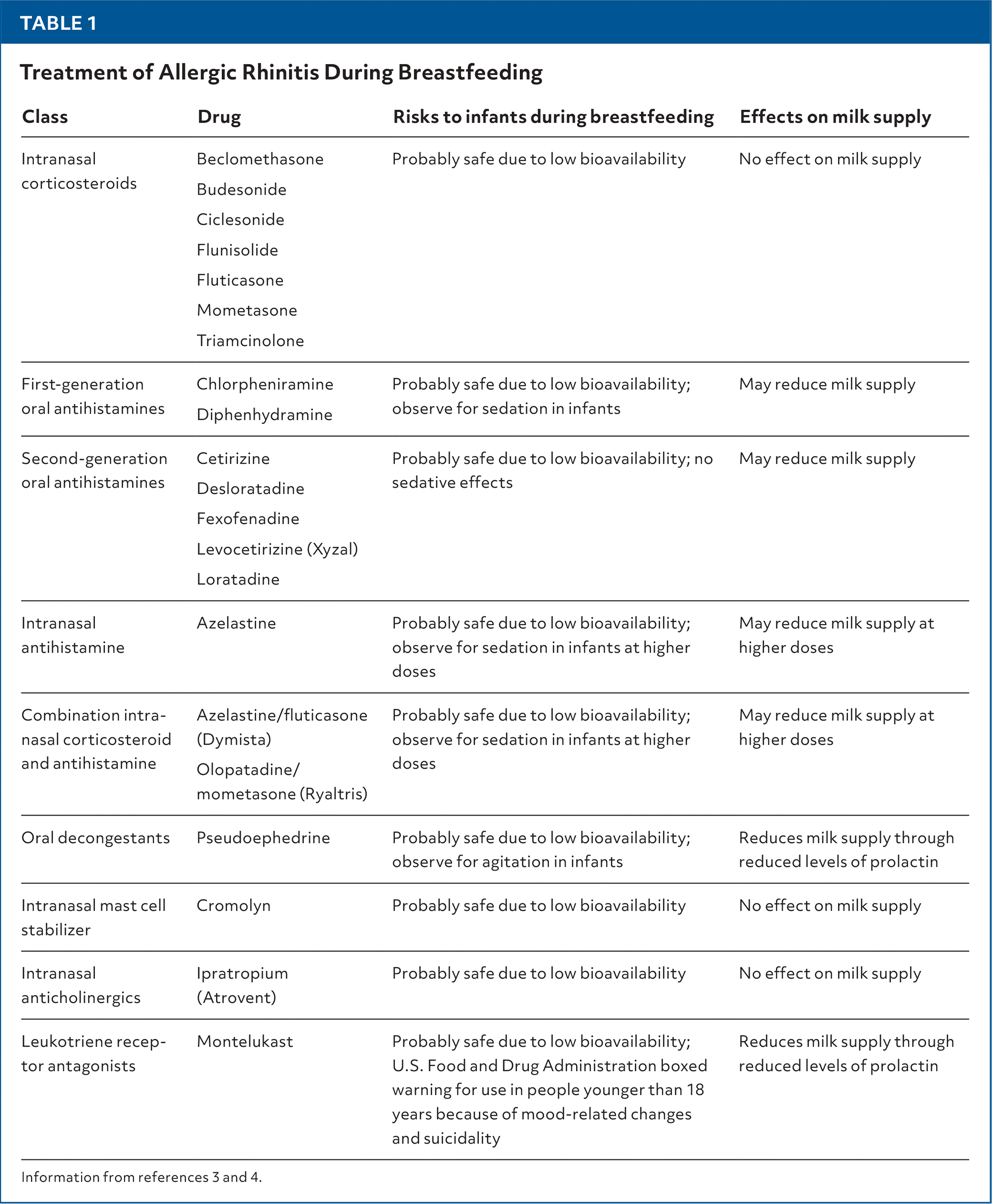
Letters to the Editor
Treatment of Allergic Rhinitis During Breastfeeding
Am Fam Physician. 2024;110(4):336
Author disclosure: No relevant financial relationships.
To the Editor:
I enjoyed the article by Drs. Weaver-Agostoni, Kosak, and Bartlett on treating allergic rhinitis in diverse patient populations, including during pregnancy.1 The article would benefit from addressing treatment in the postpartum period. Family physicians should use patient-centered decision-making when discussing the risks and benefits of allergic rhinitis medications with patients who are breastfeeding.
The American Family Physician article “Medication Safety in Breastfeeding” provided general considerations for minimizing the potential risks of drug therapy while breastfeeding,2 but there is limited high-quality evidence that evaluates the effect of medications for allergic rhinitis on lactation in patients who are breastfeeding (Table 13,4). The greatest risk of these medications is their effect on milk supply; intranasal corticosteroids, cromolyn, and ipratropium (Atrovent), followed by second-generation antihistamines are preferred because they are less likely to affect milk supply. Use of first-generation antihistamines, oral decongestants, and montelukast should be minimized while breastfeeding.2–4 Intranasal medications are generally safer than oral medications.3,4 These recommendations limit the systemic absorption of medications in breast milk and conserve milk supply.

| Class | Drug | Risks to infants during breastfeeding | Effects on milk supply |
|---|---|---|---|
| Intranasal corticosteroids | Beclomethasone Budesonide Ciclesonide Flunisolide Fluticasone Mometasone Triamcinolone | Probably safe due to low bioavailability | No effect on milk supply |
| First-generation oral antihistamines | Chlorpheniramine Diphenhydramine | Probably safe due to low bioavailability; observe for sedation in infants | May reduce milk supply |
| Second-generation oral antihistamines | Cetirizine Desloratadine Fexofenadine Levocetirizine (Xyzal) Loratadine | Probably safe due to low bioavailability; no sedative effects | May reduce milk supply |
| Intranasal antihistamine | Azelastine | Probably safe due to low bioavailability; observe for sedation in infants at higher doses | May reduce milk supply at higher doses |
| Combination intranasal corticosteroid and antihistamine | Azelastine/fluticasone (Dymista) Olopatadine/mometasone (Ryaltris) | Probably safe due to low bioavailability; observe for sedation in infants at higher doses | May reduce milk supply at higher doses |
| Oral decongestants | Pseudoephedrine | Probably safe due to low bioavailability; observe for agitation in infants | Reduces milk supply through reduced levels of prolactin |
| Intranasal mast cell stabilizer | Cromolyn | Probably safe due to low bioavailability | No effect on milk supply |
| Intranasal anticholinergics | Ipratropium (Atrovent) | Probably safe due to low bioavailability | No effect on milk supply |
| Leukotriene receptor antagonists | Montelukast | Probably safe due to low bioavailability; U.S. Food and Drug Administration boxed warning for use in people younger than 18 years because of mood-related changes and suicidality | Reduces milk supply through reduced levels of prolactin |
Family physicians should understand the effects of medications on lactation to provide full-spectrum care for the birthing person/newborn dyad. Allergic rhinitis is a common diagnosis and treatment can affect a person's ability to breastfeed effectively. Although more research is needed, medications for allergic rhinitis do not show a significant risk to infants who are breastfeeding and are likely safe for use.3,4
Editor’s Note: This letter was sent to the authors of “Allergic Rhinitis: Rapid Evidence Review,” who declined to reply.

